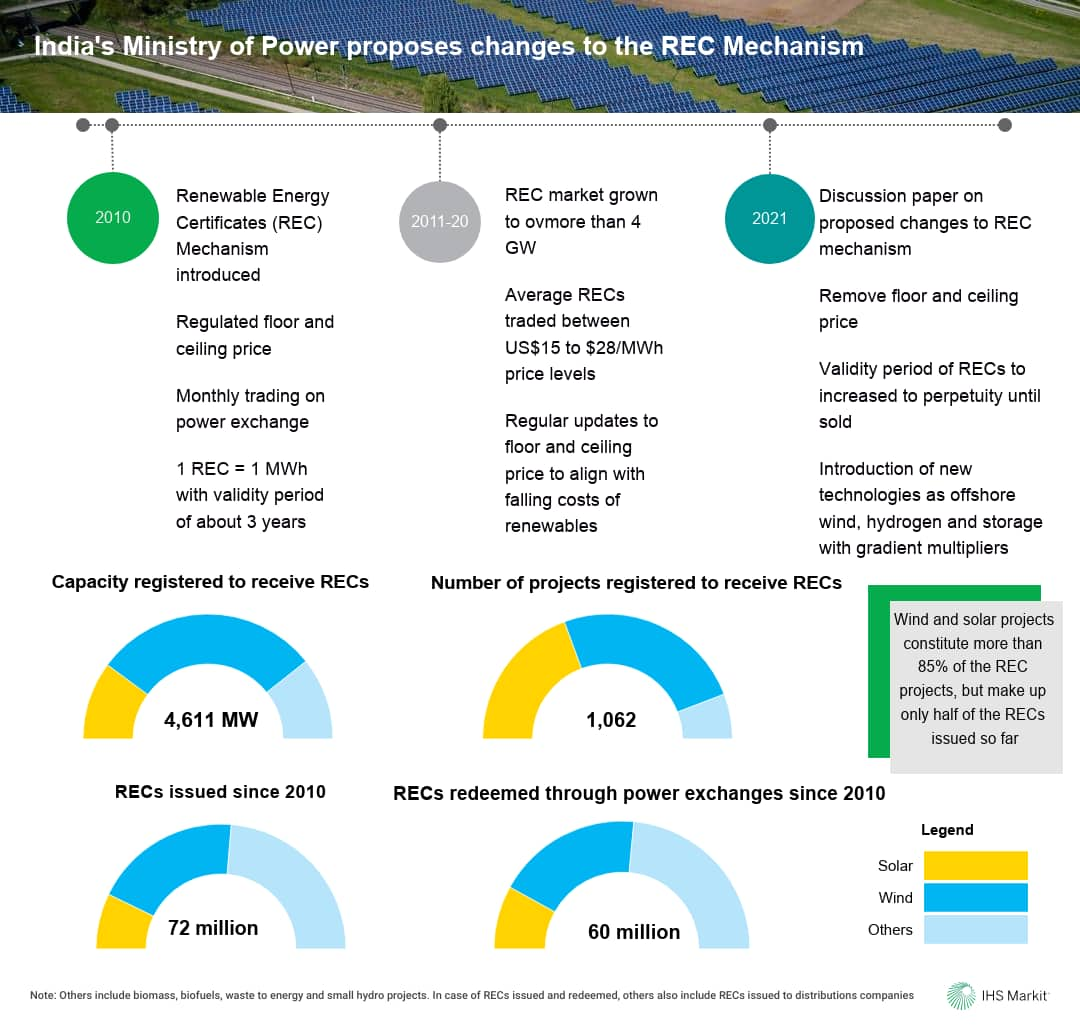A review of the recent discussion paper on Renewable Energy Certificates (REC) Mechanism
On 4th June 2021, India's Ministry of Power released a discussion paper for redesigning the renewable energy certificates (REC) mechanism. REC mechanism which was first introduced in 2010 to promote renewable energy sources (RES) in India through this market-based mechanism. The mechanism allows obligated consumers of electricity including distribution companies and open access consumers to meet their policy driven renewable purchase obligations (RPO) through purchase of the green attributes traded through the power exchanges. While over the years, the REC prices have been regulated within a floor and a ceiling price, however, because of the excess supply than demand, the realized REC prices have remained close to the floor price ranging between US$15 to $28/MWh during 2011-20.
Since July 2020, no trading has happened for RECs after the central regulator proposed removal of the floor price and bringing the ceiling price to about $15/MWh. The issue is currently sub-judice as the REC suppliers have contested the proposal.

Proposed changes in the REC mechanism in the discussion paper
The discussion paper aims at restructuring the REC mechanism by bringing it up to date. Besides, it proposes the following changes to the current mechanism:
- Promote new high-cost technologies - offshore wind, hydrogen, and pumped storage hydro by including them into the fold of REC mechanism.
- Introduce concept of technology multipliers to promote new technologies by assigning them more RECs per MWh of generation. There will be a sunset clause for the technology multiplier based on market maturity of the technology.
- All new technologies which needs to be promoted are to be identified 2 years in advance
- Propose to increase the validity period of RECs issued to perpetuity from the current validity of about 3 years, i.e. RECs to remain valid until sold.
- Floor and forbearance price for the RECs to be removed
- All new REC projects will be eligible for issuance of RECs for first 15 years from commissioning, while earlier the period was for 25 years.
- Continue to incentivize RE procurement beyond the RPO by issuing RECs to the distribution companies (DISCOMs). Besides, the paper also discusses an option to extend this incentive to both the DISCOMs and open access/ captive consumers.
- No RECs to be issued to the projects which benefit from any other support mechanism and concessions. These exemptions will be defined by the forum of regulators (FOR).
- Enhancing the role of traders and promote bilateral trades. Currently the REC transaction take place on the power exchange and cannot be traded bilaterally.
- CERC to develop monitoring and the surveillance mechanism to ensure that there is no hording of the RECs or any malpractices in the REC trading
The paper brings up an important discussion around REC mechanism which is an essential market instrument supporting renewables growth in India. The proposal is welcoming and aims to widen the scope of the current framework, however there are certain aspects which need more deliberation and further clarification.
IHS Markit feedback
Following are a few comments, suggestions, and questions for the consideration of the ministry of power:
1. Should not do away with the floor price until stricter penalty mechanism for non-compliance of RPO is implemented to create demand:
One of the key challenges with the current REC market has been excess supply with limited demand owing to the concerns regarding the non-compliance of RPO given lack of stricter implementation of penalty mechanism. IHS Markit believes CERC should consider the proposal further.
- Removal of the floor price may disincentivize the generators as it provides a minimum price guarantee. It may also impact the market liquidity in RECs, as with very low-price discovery, the suppliers may restrict to bring the capacity into this market.
- The key challenge with REC market is the excess supply while demand remains significantly lower. In terms of RPO compliance as well, there is huge lag. Only four states Karnataka, Andhra Pradesh, Rajasthan, and Gujarat achieve or overachieve their targets, while other states lag. About 20 out of 31 states achieved less than 50% of their respective RPO targets in FY2020 (Source: Stand committee on energy, Lok Sabha). The model REC regulation by FOR, recommended penalty mechanism on the inability of the obligated entity to meet the RPOs. However, the RPO penalty mechanism has not been implemented in practice, impacting the overall REC demand. What measures will be taken to ensure that there is enough demand for RECs and that penalties are implemented for non-compliance of RPO targets? Implementing a penalty equivalent of floor price may help in increasing compliance and demand of RECs at the same time.
- We recommend, the floor and forbearance price should not be done away till there is an alternate and stricter penalty mechanism in place along with monitoring protocols for applying penalties.
2. Requires more clarity on inclusion of technology:
IHS Markit welcomes the ministry's initiative to include new high-cost technologies within REC mechanism to support them with additional revenue stream till its maturity. However, the following points needs more clarification or procedural information.
- The discussion paper proposes only offshore wind, hydrogen, and pumped hydro as technologies to be promoted under the REC mechanism. However, there is no mention of battery storage which is expected to play an important role in integrating larger share of renewables in the grid in the mid to long term.
- Secondly, in the absence of any specific renewable purchase obligations (RPO) for these technologies, it is not clear, how will the demand be created for these technologies. Will the RPO target be made technology agnostic or additional categories (in addition to solar, non-solar) be created for RPOs to drive demand for the new technologies?
- Besides, another challenge with promoting new technologies (which has high initial investment costs) through the REC mechanism is the absence of long-term visibility of revenue streams through this mechanism. We propose that REC issuance for these technologies to be for a longer duration of 25 to 30 years of the project life.
- Storage technologies like - hydrogen, pumped hydro and battery storage do not create additional generation, but may be used in load shifting. Will the RECs be issued for the generation against the renewable component of the co-located or remotely located storage project?
- How will the commercial settlement take place in case of technology multipliers? Will the buyer of the RECs need to buy same number of RECs in case of both mature and emerging technologies to comply with its RPO?
3. REC validity should be limited to 3 years while trading frequency to be increased to ensure more activity:
Globally, RECs are valid for 1-2 years - Australia, an REC is valid for 1 year, while in the United Kingdom validity period of the equivalent certificates is for 2 years.
- So, India should not be considering increasing the validity and limit it to 3 years (as per current practice), which is also on a higher end. The emphasis should be on ensuring demand in the market
- Increasing the validity of the RECs to perpetuity will result in tightening of supply of RECs in market which may result in price distortion instances. It is argued that CERC will monitor the hoarding of RECs, but no clear structure is provided on penalties or process to check hoarding.
- Also, the trading frequency for RECs could be increased from the current once in a month to bi-monthly or weekly to ensure more activity.
4. Time-period for issuing RECs should be kept same else it may impact the green-field projects:
Currently, RECs are issued for the lifetime of the project i.e. 25 years.
- What is the rationale for limiting the time-period for issuing of RECs to that of first 15 years of the project life? If a project is built considering the REC revenues, and without other concessions/incentives available to RES projects, limiting the REC issuance to 15 years may affect new greenfield projects.
- REC issuance is mentioned from the date of commissioning, will the projects be eligible for REC issuance from the date of registration or date of commissioning?
- Besides, can the project re-register itself after completion of 15 years to be eligible for REC issuance?
5. What are the plans to bring synergies between different international and local market-based mechanism including I-RECs, Carbon market and ESCerts:
- Are there any plans to synergize the local REC market with international REC mechanism (I-RECs) and have transferable RECs? In preparation for COP26, incorporate the REC mechanism into a National Carbon offsets registry mechanism that can become internationally tradeable as discussed under Article 6 at COP26 start a tradeable International market.
- Are there any plans to synergize the REC mechanism with the ESCerts (Energy saving certificates) mechanism and have conversion between MWh (REC) and Mtoe (Escert)?
- Are there any timelines being discussed to transition away from RECs, as India develops a carbon price framework which enables the market-based adoption of renewables on economic and clean energy merits?
6. RPO for DISCOMs and open access consumers is preferred:
In IHS Markit views it is preferable to allow both the DISCOMs and the open access/ captive consumers to be eligible for issuance of RECs in case of higher than RPO compliance. It will allow to create an ecosystem for development of new technologies by providing an incentive to set up such projects for commercial & industrial consumption.
Learn more about our research in the Asia Pacific energy markets through our Asia Pacific Regional Integrated Service.
Ankita Chauhan is a senior renewable analyst on the Climate and Sustainability team at IHS Markit, covering research and analysis for Indian and South Asian markets.
Posted on 25 June 2021
This article was published by S&P Global Commodity Insights and not by S&P Global Ratings, which is a separately managed division of S&P Global.

